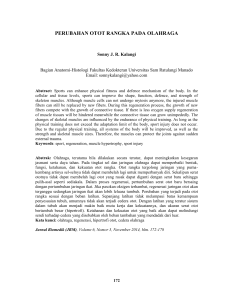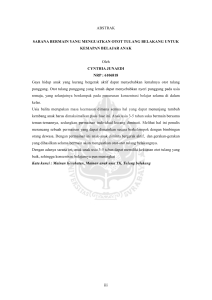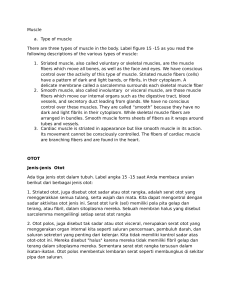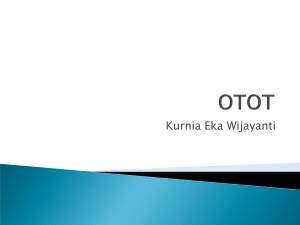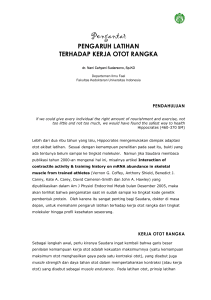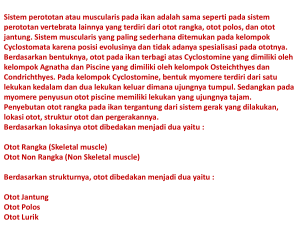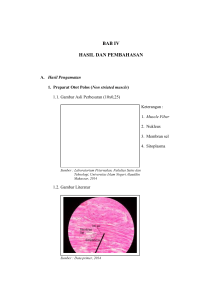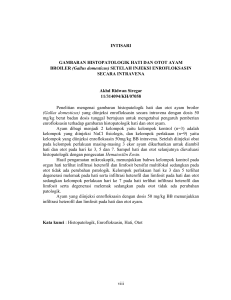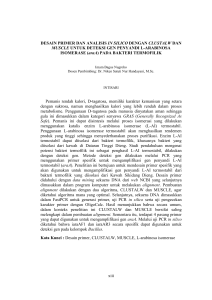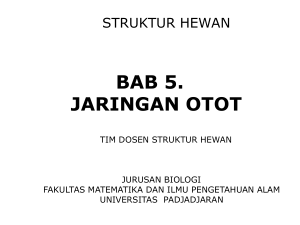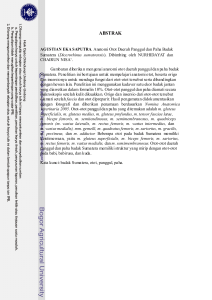Multijoint Muscles
advertisement
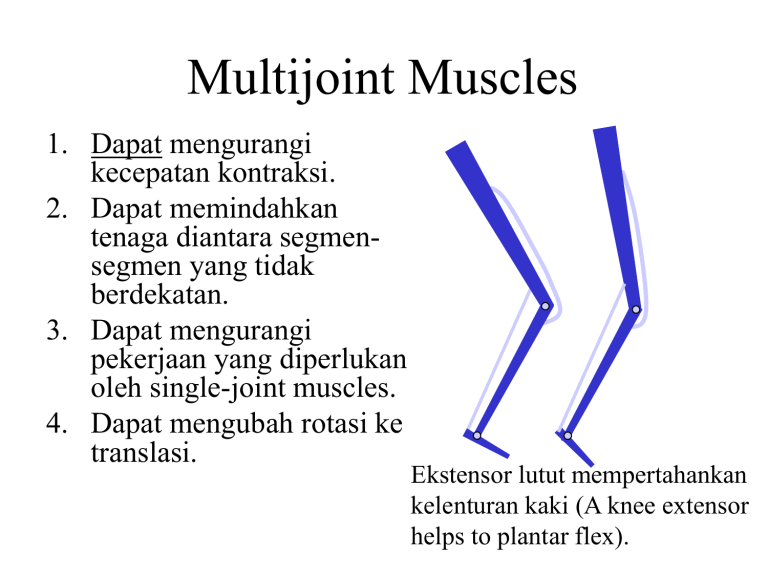
Multijoint Muscles 1. Dapat mengurangi kecepatan kontraksi. 2. Dapat memindahkan tenaga diantara segmensegmen yang tidak berdekatan. 3. Dapat mengurangi pekerjaan yang diperlukan oleh single-joint muscles. 4. Dapat mengubah rotasi ke translasi. Ekstensor lutut mempertahankan kelenturan kaki (A knee extensor helps to plantar flex). Multijoint Muscles Dapat menyebabkan active insufficiency – kemampuan terbatas dari sebuah two-joint muscle menghasilkan tenaga ketika posisi joint memempati otot yang kendur.(limited 1. ability of a two-joint muscle to produce force when joint positions place the muscle on slack.) - Ketika pergelangan tangan lentur, jari tidak dapat menghasilkan putaran maksimum karena kelenturan jari tidak dapat menyusut lagi (When wrist is fully flexed, fingers cannot produce maximum torque because finger flexors cannot shorten any more). Dapat menyebabkan passive insufficiency – ketidakmampuan sebuah two-joint muscle merenggang pada luas yang diperlukan untuk gerakan penuh pada seluruh titik yang dilewati. (inability of a two-joint muscle to stretch to the 2. extent required to allow full range of motion at all joints crossed). - Ketika lutut ditegakkan, pangkal paha tidak dapat lentur maksimal karena urat otot tidak cukup panjang.(When knee is extended, hip cannot be maximally flexed because hamstring muscles are not long enough. Stretch-Shortening (SS) Cycle (Siklus Peregangan Singkat) • Sebuah peregangan cepat diikuti gerakan konsentris dalam otot (a quick stretch followed by concentric action in the muscle) • Lebih bertenaga daripada gerakan konsentris sendiri. (more powerful than concentric action alone) • Contoh : – vertical jump: counter-movement vs. no countermovement – plyometrics membantu melatih siklus peregangan singkat. (plyometrics can be used to help train the stretch shortening cycle) Peningkatan tenaga selama siklus SS (Force Enhancement During SS Cycle) countermovement diperoleh dari peningkatan produksi tenaga sehubungan dengan: 1. neural factors (reflexes) 2. Fakta otot lebih penuh beraktivitas pada awal fasa konsentris 3. elastic contributions Pemulihan tenaga tercepat diperoleh dengan istirahat sekitar 8”-12” (Greatest return of energy is achieved using a drop of about 8”-12”) Sumber Tenaga Elastis dalam Siklus SS (Source of Elastic Energy in SS Cycle) • Komponen paralel elastis (parallel elastic component) • Komponen seri elastis CC (series elastic component) SEC PEC Muscular Force Components • stabilizing or dislocating component • rotary component – Tegak lurus pada segmen putaran (perpendicular to the rotating segment ) – Membuat putaran (causes rotation) – Paralel pada segmen putaran (parallel to rotating segment) – Stabil mengarah lipatan (stabilizing is toward joint) – Pelepasan menjauh dari lipatan (dislocating is away from joint) Muscular Force Components • Komponen bergantung sudut lipatan (components depend on the joint angle) large rotary small stabilizing small rotary large stabilizing medium rotary medium dislocating Moment Arms (d) T= F•d The torque depends on the joint angle. The moment arm adalah jarak tersingkat diantara sumbu putar dan garis aplikasi vektor the shortest distance between the axis of rotation (joint center) and the line of application of the force vector (longitudinal axis of the muscle). Moment Arm vs Joint Angle Elbow flexion/extension(tekukan/perluasan Siku) BRD = 2.015-0.458*a+3.058*a2 -1.081*a3+0.159*a4-0.0187*a5 Muscle Pain (otot yang sakit) 1. Strains (tegangan) Sobekan bagian serat (urat daging lutut) Partial tear of fibers, (eg. hamstrings) 2. Contusions (luka memar) Compressive force bruising 3. Cramps (kejang) Kekejangan otot (Muscle spasm, not well understood) 4. DOMS Delayed onset muscle soreness, 24-72 hours after unaccustomed exercise, especially eccentric activity (latihan yang tidak biasa) 5. Compartment Syndrome (sindrom kamar) Meningkatkan tekanan selama muscle compartment, dapat merusak stuktur-stuktur neural atau vascular. Muscle Temperature (Suhu Otot) •Fungsi otot paling efisien pada suhu 38.5°C (101°F). •Suhu otot yang ditinggikan berubah pada kurva tenaga-kecepatan (elevated muscle temperature shift in force-velocity curve) •Peningkatan tegangan isometris maksimum •Kecepatan konduksi syarat frekuensi stimulasi tenaga otot •Aktivitas enzyme efisiensi kontraksi syaraf •Elastisitas kolagen peregangan otot tenaga otot •Peningkatan kecepatan maksimum dari pemendekan otot •Memerlukan sedikit unit motor untuk menopang beban yang diberikan load •Suhu tubuh terlalu tinggi heat exhaustion or heat stroke Temperature Effects on FV (Efek suhu pada FV) Kinetic Link
